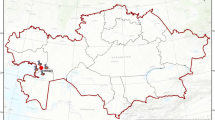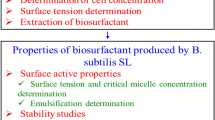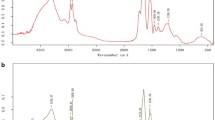Abstract
Three biosurfactant-producing indigenous microorganisms (XDS1, XDS2, XDS3) were isolated from a petroleum reservoir in the Daqing Oilfield (China) after polymer flooding. Their metabolic, biochemical, and oil-degradation characteristics, as well as their oil displacement in the core were studied. These indigenous microorganisms were identified as short rod bacillus bacteria with white color, round shape, a protruding structure, and a rough surface. Strains have peritrichous flagella, are able to produce endospores, are sporangia, and are clearly swollen and terminal. Bacterial cultures show that the oil-spreading values of the fermentation fluid containing all three strains are more than 4.5 cm (diameter) with an approximate 25 mN/m surface tension. The hydrocarbon degradation rates of each of the three strains exceeded 50%, with the highest achieving 84%. Several oil recovery agents were produced following degradation. At the same time, the heavy components of crude oil were degraded into light components, and their flow characteristics were also improved. The surface tension and viscosity of the crude oil decreased after being treated by the three strains of microorganisms. The core-flooding tests showed that the incremental oil recoveries were 4.89–6.96%. Thus, XDS123 treatment may represent a viable method for microbial-enhanced oil recovery.





Similar content being viewed by others
References
Belyaev, S. S., Borzenkov, I. A., Nazina, T. N., Rozanova, E. P., Glumov, I. F., Ibatullin, R. R., et al. (2004). Use of microorganisms in the biotechnology for the enhancement of oil recovery. Mikrobiologiya, 73, 687–697 [Microbiology (Engl. Transl.), vol. 73, no. 5, pp. 590–598].
McInerney, M. J., Nagle, D. P., & Knapp, R. M. (2005). Microbially enhanced oil recovery: past, present, and future. In B. Ollivier & M. Magot (Eds.), Petroleum microbiology (pp. 215–237). Washington: ASM Press.
Aitken, C. M., Jones, D. M., & Larter, S. R. (2004). Anaerobic hydrocarbon biodegradation in deep subsurface oil reservoirs. Nature, 431, 291–294.
Head, I. M., Jones, D. M., & Larter, S. R. (2003). Biological activity in the deep subsurface and the origin of heavy oil. Nature, 426, 344–352.
Orphan, V. J., Taylor, L. T., Hafenbradl, D., & Delong, E. F. (2000). Culture-dependent and culture-independent characterization of microbial assemblages associated with high-temperature petroleum reservoirs. Applied and Environmental Microbiology, 66, 700–711.
Roling, W. F., Head, I. M., & Larter, S. R. (2003). The microbiology of hydrocarbon degradation in subsurface petroleum reservoirs: perspectives and prospects. Research in Microbiology, 154, 321–328.
Nazina, T. N., Grigor’ian, A. A., Shestakova, N. M., Babich, T. L., Ivoĭlov, V. S., Feng, Q., et al. (2007). Microbiological investigations of high-temperature horizons of the Kongdian petroleum reservoir in connection with field trial of a biotechnology for enhancement of oil recovery. Mikrobiologiia, 76, 329–339 (in Russian).
Nazina, T. N., Grigor’ian, A. A., Feng, T., Shestakova, N. M., Babich, T. L., Pavlova, N. K., et al. (2007). Microbiological and production characteristics of the high-temperature Kongdian bed revealed during field trial of biotechnology for the enhancement of oil recovery. Mikrobiologiia, 76, 340–353 (in Russian).
She, Y. H., Zhang, X. M., Zheng, B. W., & Zhang, F. (2008). Microbial diversity research of produced water from Daqing Oil reservoir after polymer flooding, The 2nd International Conference on Bioinformatics and Biomedical Engineering (ICBBE),May 16–18, 2008, Shanghai, China.
Banat, I. M. (1995). Biosurfactants production and possible uses in microbial enhanced oil recovery and oil pollution remediation—a review. Bioresource Technology, 51, 1–12.
Kaster, K. M., Bonaunet, K., Berland, H., Kjeilen-Eilertsen, G., & Brakstad, O. G. (2009). Characterisation of culture-independent and -dependent microbial communities in a high-temperature offshore chalk petroleum reservoir. Antonie van Leeuwenhoek, 96, 423–439.
Pham, V. D., Hnatow, L. L., Zhang, S., Fallon, R. D., Jackson, S. C., Tomb, J. F., et al. (2009). Characterizing microbial diversity in production water from an Alaskan mesothermic petroleum reservoir with two independent molecular methods. Environmental Microbiology, 11, 176–187.
Youssef, N., Elshahed, M. S., & McInerney, M. J. (2009). Microbial processes in oil fields: culprits, problems, and opportunities. Advances in Applied Microbiology, 66, 141–251. Review.
Anita, S. K., Kalpana, M., & Bhavanath, J. (2007). Evaluation of biosurfactant/bioemulsifier production by a marine bacterium. Bulletin of Environmental Contamination and Toxicology, 79, 617–621.
Mohebali, G., Ball, A., Kaytash, A., & Rasekh, B. (2007). Stabilization of water/gas oil emulsions by desulfurizing cells of Gordonia alkanivorans RIPI90A. Microbiology, 153, 1573–1581.
Wang, Q. H., Fang, X. D., Bai, B. J., Liang, X. L., Shuler, P. J., Goddard, W. A., et al. (2007). Engineering bacteria for production of rhamnolipid as an agent for enhanced oil recovery. Biotechnology and Bioengineering, 98(4), 842–853.
Liu, J. F., Ma, L. J., Mu, B. Z., Liu, R. L., Ni, F. T., & Zhou, J. X. (2005). The field pilot of microbial enhanced oil recovery in a high temperature petroleum reservoir. Journal of Petroleum Science and Engineering, 48, 265–271.
Li, D. S., Lu, S. L., Liu, Y., & Wang, D. M. (2004). The effect of biosurfactant on the interfacial tension and adsorption loss of surfactant in ASP flooding. Colloids and Surfaces. A, Physicochemical and Engineering Aspects, 244, 53–60.
Halim, A. Y., Fauzi, U. D., Siregar, S., Soewono, E., Gunawan, A. Y., Astuti, D. I., et al. (2009). Microbial enhanced oil recovery: an investigation of bacteria ability to live and alter crude oil physical characteristics in high pressure condition. SPE 123506, SPE Asia Pacific Oil and Gas Conference and Exhibition held in Jakarta, Indonesia, 4–6 August 2009.
Abe, F., Kato, C., & Horikoshi, K. (1999). Pressure-regulated metabolism in microorganisms. Trends Microbiol, 7, 447–453.
Acknowledgements
We gratefully acknowledge the support of the 863 Program (2008AA06Z204) of the Ministry of Science and Technology and the National Natural Science Foundation (Grant No.50974022) in P.R. China.
Author information
Authors and Affiliations
Corresponding author
Rights and permissions
About this article
Cite this article
She, YH., Zhang, F., Xia, JJ. et al. Investigation of Biosurfactant-Producing Indigenous Microorganisms that Enhance Residue Oil Recovery in an Oil Reservoir After Polymer Flooding. Appl Biochem Biotechnol 163, 223–234 (2011). https://doi.org/10.1007/s12010-010-9032-y
Received:
Accepted:
Published:
Issue Date:
DOI: https://doi.org/10.1007/s12010-010-9032-y




